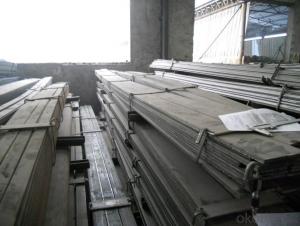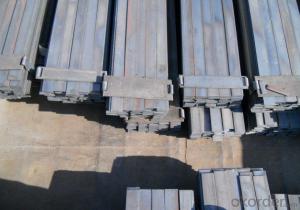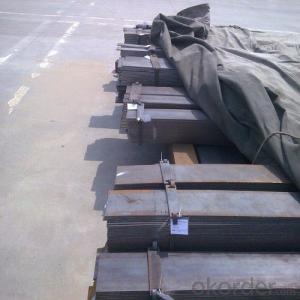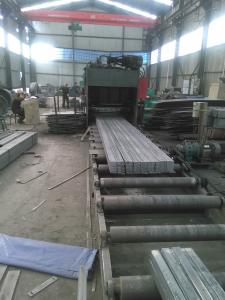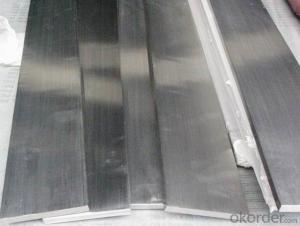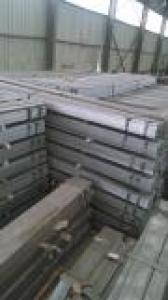Steel Flat Bar Grade JIS SS400 B Added
- Loading Port:
- Tianjin
- Payment Terms:
- TT or LC
- Min Order Qty:
- 50 m.t.
- Supply Capability:
- 10000T m.t./month
OKorder Service Pledge
OKorder Financial Service
You Might Also Like
Product Description:
OKorder is offering Steel Flat Bar Grade JIS SS400 B Added at great prices with worldwide shipping. Our supplier is a world-class manufacturer of steel, with our products utilized the world over. OKorder annually supplies products to African, South American and Asian markets. We provide quotations within 24 hours of receiving an inquiry and guarantee competitive prices.
Product Applications:
Steel Flat Bar Grade JIS SS400 B Added are ideal for structural applications and are widely used in the construction of buildings and bridges, and the manufacturing, petrochemical, and transportation industries.
Product Advantages:
OKorder's Steel Flat Bar Grade JIS SS400 B Added are durable, strong, and wide variety of sizes.
Main Product Features:
· Premium quality
· Prompt delivery & seaworthy packing (30 days after receiving deposit)
· Can be recycled and reused
· Mill test certification
· Professional Service
· Competitive pricing
Product Specifications:
Manufacture: slited
Slitting precision (width) : 0.5 mm or less
Raw material: Q235B, Q345B, Q235-1 b
crosscutting precision (length) : 2 mm or less
Processing: the thickness of 2.0-16 mm;
Shear length: 2000 mm above
Wide degree: 15-1250 - mm;
Leveling precision: 1-2 MM square
Packaging: Export packing, nude packing, bundled
FAQ:
Q1: How many tons of steel products could be loaded in containers?
A1: Usually the steel products are delivered by bulk vessel because of the large quantity and the freight. However, there are no bulk vessel enter some seaports so that we have to deliver the cargo by containers. The 6m steel product can be loaded in 20FT container, but the quantity is changed according to the size, usually from 18tons to 25tons.
Q2: what is the difference between actual weight and theoretical weight?
A2: All the section steel has two weights: actual weight and theoretical weight. Actual weight is the weighing out when the product delivered from the mill. Theoretical weight is calculated by pieces. The invoice can be based on each of them as your request.
Q3: How soon can we receive the product after purchase?
A3: Within three days of placing an order, we will arrange production. The normal sizes with the normal grade can be produced within one month. The specific shipping date is dependent upon international and government factors, the delivery to international main port about 45-60days.
Images:

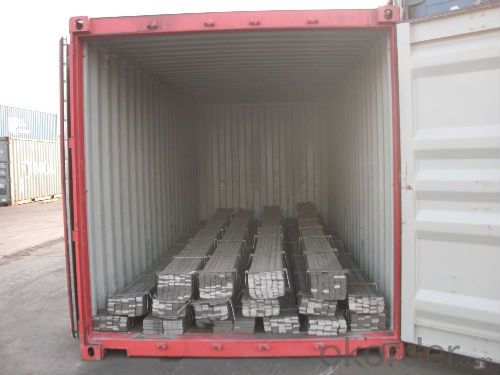
- Q:What is the cost of a steel flat bar?
- The cost of a steel flat bar can vary depending on several factors such as its size, grade, and market conditions. It is best to check with a supplier or retailer for the most accurate and up-to-date pricing information.
- Q:How is a steel flat bar different from other types of steel bars?
- A steel flat bar, as the name suggests, is characterized by its flat and rectangular shape. Unlike other types of steel bars such as round or square bars, which have circular or square cross-sections respectively, a flat bar has a wide and flat surface area. This unique shape makes it ideal for applications where a strong and sturdy support or structural element is required, such as in construction, manufacturing, or DIY projects.
- Q:How to use -40*4 galvanized steel bar to do grounding electrode?
- The -40*4 galvanized flat steel is used as the grounding electrode, and the horizontal grounding electrode needs to be welded with the lead wire.
- Q:Please: hot galvanized flat steel and copper clad steel ground!
- Compared with galvanized flat steel and other grounding materials, copper clad steel ground wire features: 1, corrosion resistance is better: no residual inside the bimetal, better corrosion resistance. The horizontal continuous casting process adopts high temperature melting, and the residue is calcined to overflow the copper surface, and can not be left in the copper clad steel conductor, so the corrosion phenomenon can not occur inside. 2 、 better electrical performance: the surface of oxygen free copper, good conductivity, the inner layer of high-quality carbon steel, skin effect principle, conductive, magnetic characteristics are excellent. The resistance is much lower than conventional materials such as steel, galvanized steel, etc. the surface layer is oxygen free copper.
- Q:Can steel flat bars be used for making conveyor systems?
- Yes, steel flat bars can be used for making conveyor systems. Steel flat bars are known for their strength, durability, and resistance to corrosion, making them an ideal choice for conveyor systems that need to handle heavy loads and withstand constant use. The flat shape of the bars allows for easy attachment of rollers or other components, making it easier to assemble and customize the conveyor system. Additionally, steel flat bars can be easily welded or bolted together, providing flexibility in designing and constructing conveyor systems of various sizes and configurations.
- Q:Can steel flat bars be used for manufacturing architectural facades or cladding?
- Yes, steel flat bars can be used for manufacturing architectural facades or cladding. Steel is a versatile and durable material that is often chosen for its strength and aesthetic appeal. Steel flat bars can be easily fabricated and shaped to fit specific design requirements, making them suitable for various architectural applications. Steel flat bars offer several advantages for architectural facades or cladding. Firstly, steel has excellent structural properties, providing stability and resistance against external forces such as wind or seismic activity. This makes it a reliable choice for buildings that require a strong and sturdy exterior. Additionally, steel flat bars can be finished in different ways to enhance their visual appeal. They can be painted, powder coated, or even left untreated for a more industrial look. Steel's natural gray or metallic appearance can complement a wide range of architectural styles, from modern to traditional. Furthermore, steel flat bars are highly resistant to corrosion and weathering, which is crucial for exterior applications. With proper maintenance, steel facades or cladding can withstand harsh weather conditions and maintain their appearance for many years. However, it is important to consider the specific project requirements and consult with architects, engineers, and manufacturers to ensure that the chosen steel flat bars meet the necessary specifications and standards for architectural facades or cladding.
- Q:What are the different surface treatments available for steel flat bars to enhance aesthetics?
- Steel flat bars have several surface treatments available that can improve their appearance and aesthetics. Some of the most common treatments include: 1. Polishing: By grinding and buffing the steel, a smooth and glossy surface is created, enhancing its shine and reflective properties for a sleek and sophisticated look. 2. Brushing: This treatment involves using abrasive materials like wire brushes to create fine lines on the steel's surface, giving it a textured and decorative appearance that adds depth and character. 3. Powder coating: Electrostatically applying a dry powder to the steel surface and then heating it creates a smooth and durable finish. This treatment not only enhances aesthetics with a wide range of colors and finishes but also improves resistance to corrosion, chemicals, and UV rays. 4. Galvanizing: Applying a protective layer of zinc to the steel surface enhances aesthetics with a shiny and metallic appearance while providing excellent corrosion resistance, making it suitable for outdoor applications. 5. Anodizing: An electrochemical process creates a protective oxide layer on the steel surface, enhancing aesthetics with a variety of colors and finishes, as well as improved resistance to corrosion, abrasion, and weathering. 6. Plating: Applying a thin layer of metal, such as chrome or nickel, onto the steel surface enhances aesthetics with a shiny and reflective appearance, while also providing additional protection against corrosion and wear. In conclusion, these surface treatments offer various options to enhance the aesthetics of steel flat bars, making them suitable for a wide range of applications where appearance is crucial, including architectural designs, interior decoration, furniture, and the automotive industry.
- Q:How do steel flat bars compare to wood for certain applications?
- Certain applications benefit from the use of steel flat bars instead of wood for several reasons. Firstly, steel is significantly stronger and more durable than wood, making it ideal for heavy-duty applications where strength is of utmost importance. Steel flat bars can withstand higher loads and pressures compared to wooden bars, making them suitable for providing structural support in construction projects. Moreover, steel flat bars do not succumb to issues such as rot, decay, or pest infestations, which are prevalent in wood. This renders steel a more reliable and long-lasting material, especially in outdoor or moist environments. Additionally, steel is fire-resistant, unlike wood, which can be a critical consideration in applications where fire safety is a concern. Another advantage of steel flat bars lies in their consistent and uniform dimensions. Unlike wood, which can vary in size and shape due to natural defects, steel flat bars are precisely manufactured and maintain consistent dimensions throughout. This facilitates ease of use and ensures accurate and precise fittings in construction or fabrication applications. Furthermore, steel flat bars are easily recyclable, contributing to a more sustainable choice compared to wood. Steel is highly recyclable, and opting for steel flat bars over wood aids in reducing deforestation and minimizing environmental impact. Nevertheless, it is important to acknowledge that wood also possesses advantages in certain applications. Wood is a natural material that imparts a warm and visually appealing appearance, which may be desirable in architectural or interior design projects. Additionally, wood can be more manageable and offer greater flexibility in terms of shaping or customization. In conclusion, steel flat bars surpass wood in terms of strength, durability, resistance to rot and pests, fire safety, and dimensional consistency. However, the selection between steel and wood ultimately hinges on the specific requirements and aesthetics of the given application.
- Q:How do steel flat bars contribute to the overall sustainability of residential projects?
- There are several ways in which steel flat bars contribute to the overall sustainability of residential projects. To begin with, steel is an incredibly durable and long-lasting material. Steel flat bars have the ability to resist corrosion, weathering, and pests, meaning that they require minimal maintenance throughout their lifespan. This durability ensures that residential structures built with steel flat bars have a longer lifespan, reducing the need for frequent repairs and replacements. As a result, this reduces waste and conserves resources. In addition, steel is one of the most recycled materials globally. At the end of their life, steel flat bars can be easily recycled, thus reducing the demand for new steel production and the associated environmental impacts. This recycling process requires less energy and emits fewer greenhouse gases compared to the production of new steel. By incorporating steel flat bars into residential projects, we are actively promoting the reuse and recycling of materials, thus contributing to the circular economy. Moreover, steel flat bars offer strength and versatility in construction. Their high strength-to-weight ratio allows for lighter structural elements, which reduces the overall weight of the building and the amount of material needed. This not only minimizes the environmental impact during the construction phase but also reduces the load on the foundation, potentially leading to energy savings over the lifespan of the building. Steel flat bars also provide design flexibility, further contributing to the sustainability of residential projects. They are available in various sizes, shapes, and finishes, allowing architects and engineers to create innovative and efficient designs. This flexibility enables the optimization of material usage, minimizing waste and maximizing resource efficiency. Lastly, steel flat bars are fire-resistant, making them a safe choice for residential construction. This fire resistance enhances the overall safety of the building and reduces the risk of fire-related damage or loss. Ultimately, this helps minimize the environmental impact associated with rebuilding or repair. Overall, incorporating steel flat bars into residential projects promotes sustainability by providing durability, recyclability, strength, design flexibility, and fire resistance. These sustainable features help reduce waste, conserve resources, and minimize the environmental footprint of the built environment.
- Q:Do steel flat bars have a specific surface hardness?
- Yes, steel flat bars have a specific surface hardness. The surface hardness of steel flat bars is typically determined by the specific grade or type of steel used in their manufacturing. Different types of steel have varying levels of hardness, which can be measured using different scales such as the Rockwell hardness scale. The surface hardness of steel flat bars is important as it affects their resistance to wear, abrasion, and deformation. It is crucial to select the appropriate grade of steel flat bars with the desired surface hardness for specific applications to ensure optimal performance and durability.
1. Manufacturer Overview |
|
|---|---|
| Location | |
| Year Established | |
| Annual Output Value | |
| Main Markets | |
| Company Certifications | |
2. Manufacturer Certificates |
|
|---|---|
| a) Certification Name | |
| Range | |
| Reference | |
| Validity Period | |
3. Manufacturer Capability |
|
|---|---|
| a)Trade Capacity | |
| Nearest Port | |
| Export Percentage | |
| No.of Employees in Trade Department | |
| Language Spoken: | |
| b)Factory Information | |
| Factory Size: | |
| No. of Production Lines | |
| Contract Manufacturing | |
| Product Price Range | |
Send your message to us
Steel Flat Bar Grade JIS SS400 B Added
- Loading Port:
- Tianjin
- Payment Terms:
- TT or LC
- Min Order Qty:
- 50 m.t.
- Supply Capability:
- 10000T m.t./month
OKorder Service Pledge
OKorder Financial Service
Similar products
New products
Hot products
Hot Searches
Related keywords









